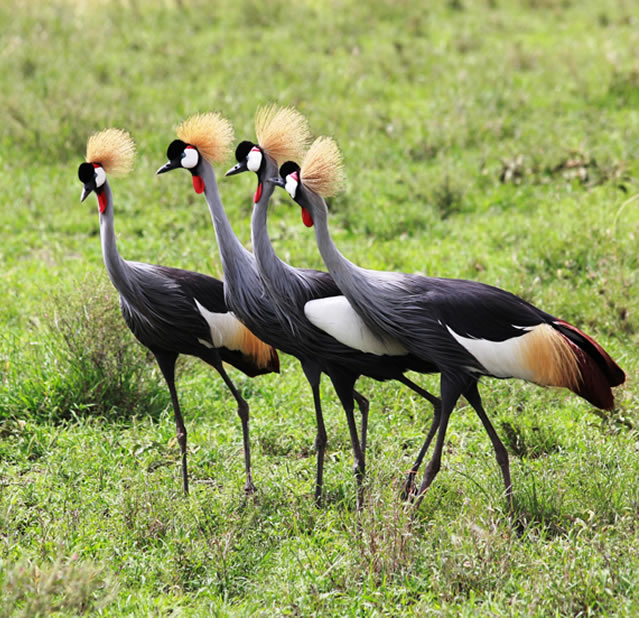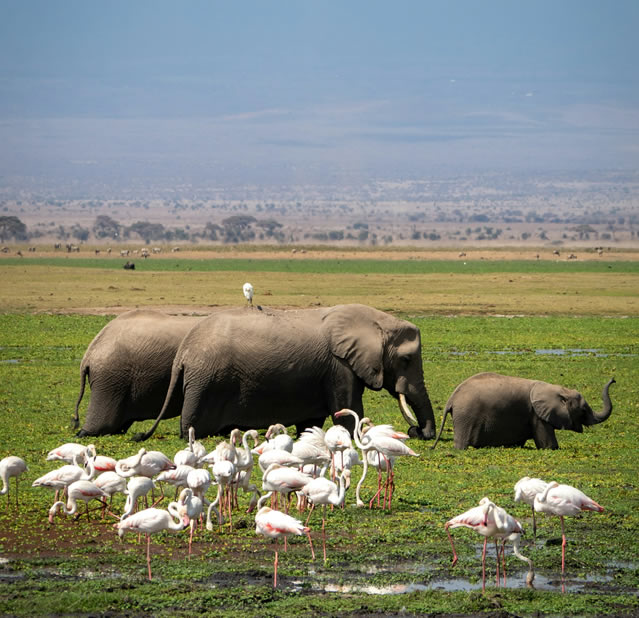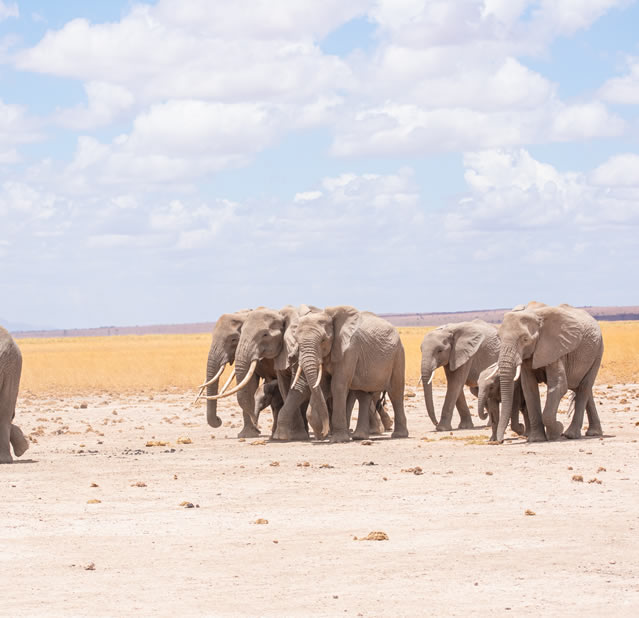AMBOSELI NATIONAL PARK
Amboseli is justly famous for it’s big game – elephants, lions and cheetahs are the main attractions – and for it’s great scenic beauty.
The 3810sqkm (1,259sq miles) of this National Park and Game Reserve embody five main wildlife habitats, plus a generally dry lake-bed, Lake Amboseli, from which it takes it’s name. These are open plains; extensive stands of yellow-barked acacia woodland; rocky, lava strewn thorn-bush country; swamps and marshes; and at the western end of the Reserve, above Namanga, the massif of Oldoinyo Orok rising to over 2,760 (8,300ft) and still for the most part zoologically unexplored.
The landscape is everywhere dominated by the glistening, majestic snow-cap of Kilimanjaro immediately to the south – Africa’s highest mountain (5,894m-19,340ft) – a fitting back-drop to a wild region where the pastoral Masai and their cattle have lived in harmony with wild creatures for many a century.
Amboseli may be reached from Nairobi by two main routes. The first is to Athi River and thence along the main Kajiado-Namanga-Arusha road, turning left through the National Park main gate at Namanga to Ol Tukai Lodge, 75km (47 miles) on. Total distance from Nairobi is 240km (150 miles). The second route is from Nairobi along the main Mombasa Road to some 16km (10 miles) past Emali, then branching right and following the main Loitokitok road: approximately 64km (40 miles) along this road it forks right and the Lodge is 32km(20 miles) farther on. Total mileage from Nairobi is 228km (142 miles). Accommodation is available at Amboseli New Lodge, Ol Tukai Lodge, Serena Lodge, Ol Tukai Tented Camp and the Namanga Hotel. Camp sites are also available.
The main game-viewing area of Amboseli lies in the eastern half of the Park, in the vicinity of Ol Tukai Lodge and Lakes Engoni Naibor and Loginya. Here a network of roads and tracks opens up a wild life paradise.
Elephant, Lion, Leopard, Cheetah, Masai Giraffe and Buffalo may all be encountered during a single morning’s drive of about 90km (50-60 miles), together with plains game such as Common Zebra, Eland, Coke’s Hartebeest, White-bearded Gnu, Common Waterbuck, Thompson’s and Grant’s Gazelle and Impala. Black Rhino can still be seen occasionally although they are now rare due to poaching in the mid-1970’s.
In the dry bush country towards Namanga, and in the arid area en route to Emali, two especially interesting antelopes may be found: the long-necked Gerenuk – often called the `Giraffe-necked Antelope’ –and the Fringe-eared Oryx. Smaller mammals always in evidence include Black-faced Vervet Monkey and Yellow Baboon, Black-headed Jackals, Spotted Hyaena and Bat-eared Foxes. The last may often be seen basking in the sun outside their dens or in the open plains.
Bird life is equally abundant, especially in the vicinity of the lakes and swamps where a great variety of water birds may be seen. That rarity in East Africa, the Madagascar Squacco Heron, turns up at fairly regular intervals and the plover with the habits of a lily-trotter, the Long-toed Lapwing, is a resident in small numbers. Sandgrouse of three species, Yellow-throated, Chestnut-bellied and Black-faced, water in their hundreds during the dry season, announcing their arrival at their favourite drinking place with far-carrying gutteral sounding flock calls.
Birds of prey are verywell represented. Including the six species of vultures no less than 47 different kinds have been recorded from Amboseli, amongst which are two great rarities, The Taita Falcon and the Southern Banded Harrier Eagle.
Around the lodges and tented camp, visitors will see flocks of a yellow weaver-bird with a patch of chestnut on the nape. This is the extremely local Taveta Golden Weaver, which outside of Amboseli may lightly be considered a rare bird. But the bird which quickly draws attention to itself on account of it’s brilliant plumage and fearless behaviour – it will alight on your table and partake of bread and cake crumbs – is the Superb Starling.





